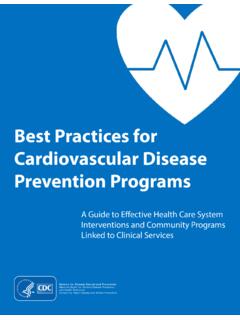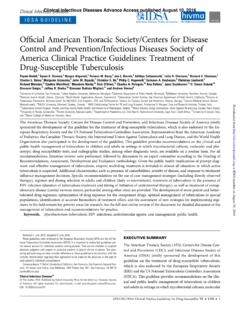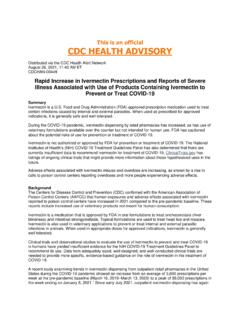Transcription of CDC Division for Heart Disease and Stroke Prevention
1 CDC Division for Heart Disease and Stroke Prevention State Heart Disease and Stroke Prevention Program EvaluationEvaluationGuideGuideDeveloping and Using aLogic ModelDepartment of Health and Human Services Centers for Disease control and Prevention National center for Chronic Disease Prevention and Health Promotion Acknowledgements This guide was developed for the Division for Heart Disease and Stroke Prevention under the leadership of Susan Ladd and Jan Jernigan in collaboration with Nancy Watkins, Rosanne Farris, Belinda Minta, and Sherene Brown. State Heart Disease and Stroke Prevention programs were invaluable in the development and fine-tuning of this guidance document. Their review contributed significantly to the clarity and utility of this guide. Special thanks are extended to: Susan Mormann (North Dakota Department of Health), Ghazala Perveen (Kansas Department of Health and Environment), Ahba Varma (North Carolina Department of Health and Human Services), and Namvar Zohoori (Arkansas Department of Health and Human Services).
2 We encourage readers to adapt and share the tools and resources in the document to meet program evaluation needs. For further information, contact the Division for Heart Disease and Stroke Prevention , Applied Research and Evaluation Branch at or (990) 488-2424. Heart Disease and Stroke Prevention Program Evaluation Guides Introduction Purpose The Heart Disease and Stroke Prevention (HDSP) Program Evaluation Guides are a series of evaluation technical assistance tools developed by the Centers for Disease control and Prevention (CDC), Division for Heart Disease and Stroke Prevention , to assist in the evaluation of Heart Disease and Stroke Prevention activities within states. The guides are intended to offer guidance, consistent definition of terms, and aid skill building on a wide range of general evaluation topics and selected specific topics. They were developed with the assumption that state health departments have varied experience with program evaluation and a range of resources allocated to program evaluation.
3 In any case, these guides clarify approaches to and methods for evaluation, provide examples specific to the scope and purpose of the state HDSP programs, and recommend resources for additional reading. Some guides will be more applicable to evaluating capacity building activity and others more focused on interventions. Although examples provided in the guides are specific to HDSP programs, the information might also prove valuable to other state health department programs, especially chronic Disease programs. Background Heart Disease and Stroke , the primary components of cardiovascular Disease (CVD), are leading causes of death and disability in the United States. As the burden of Heart Disease and Stroke continues to increase, these conditions are projected to remain the number one and two causes of death worldwide through the year 2020. In the United States alone, CVD affects million Americans and claims nearly 1 million lives annually among people of all racial/ethnic groups and ages.
4 In 1998, the Congress provided funding for CDC to initiate a national, state-based Heart Disease and Stroke Prevention program. As of July 2005, CDC funds Heart Disease and Stroke Prevention programs in 32 states and the District of Columbia. The priority areas for State activities are: Increase control of high blood pressure. Increase control of high cholesterol. Increase awareness of signs and symptoms of Heart attack and Stroke and the need to call 9-1-1. Improve emergency response. Improve quality of care. Eliminate disparities. Many factors increase the risk of developing Heart Disease and Stroke . State-based programs must therefore use strategies that target multiple risk factors in many different settings, including health care settings, work sites, communities, and school worksites to be effective. States are encouraged to build capacity, use evidence-based approaches when they exist, and develop innovative interventions to address Heart Disease and Stroke Prevention .
5 CDC-funded states are charged with providing evidence of capacity, of intervention, and of change within their state and are encouraged to build evidence for innovative and promising practices. Introduction to Guides In 2003, CDC convened key public health partners, including state programs, to develop A Public Health Action Plan to Prevent Heart Disease and Stroke . The Action Plan identifies targeted recommendations and specific action steps necessary to reduce the health and economic toll caused by Heart Disease and Stroke and supports the identification of innovative ways to monitor and evaluate policies and programs. The Action Plan is available online at the guides The guides are intended to be companion pieces to existing program evaluation documents. The CDC State Heart Disease and Stroke Prevention Program Evaluation Framework is located on the Internet at The document is also available on CDROM by contacting or your CDC project officer. The guide topics are divided broadly into two categories, fundamentals and capacity building- or intervention-related.
6 The guides in the fundamentals series will be completed first and will cover general evaluation topics using specific HDSP examples. Capacity building- and intervention-related guides will provide the tools and techniques to evaluate capacity building activities, like the effectiveness of partnerships, and interventions in the health care, work site, and community settings. Some of the guides will be developed for evaluations of specific interventions and others will focus on tools for evaluating interventions. Because states have different levels of experience and involvement with evaluation, the series of guides will range from very basic to more advanced topics. Depending on the evaluation capacity of state programs, some guides will be more useful to program staff than others. The guides are expected to be distributed over time. They will be posted online for easy review and access. State programs should review the guides as they are distributed and determine which are most applicable given current resources and activities.
7 The series will be expanded and enhanced as additional needs are identified and as state evaluation capacity is increased. States are encouraged to provide feedback to the Evaluation Team on the utility of guides and suggested topics for future guides. Bibliography American Heart Association. Heart Disease and Stroke Statistics 2006 Update. Dallas, Tex: American Heart Association; 2006. Centers for Disease control and Prevention . Prevention Works: CDC Strategies for a Heart Healthy and Stroke Free America. Atlanta, GA: Department of Health and Human Services; 2003. Available at to Guides Heart Disease and Stroke Prevention Program Evaluation Guide Developing and Using a Logic Model The evaluation guide Logic Models offers a general overview of the development and use of logic models as planning and evaluation tools. A feedback page is provided at the end of this guide. We will appreciate your comments. Logic models are tools for planning, describing, managing, communicating, and evaluating a program or intervention.
8 They graphically represent the relationships between a program s activities and its intended effects, state the assumptions that underlie expectations that a program will work, and frame the context in which the program operates. Logic models are not static documents. In fact they should be revised periodically to reflect new evidence, lessons learned, and changes in context, resources, activities, or expectations. Logic models increase the likelihood that program efforts will be successful because they: Communicate the purpose of the program and expected results. Describe the actions expected to lead to the desired results. Become a reference point for everyone involved in the program. Improve program staff expertise in planning, implementation, and evaluation. Involve stakeholders, enhancing the likelihood of resource commitment. Incorporate findings from other research and demonstration projects. Identify potential obstacles to program operation so that staff can address them early on.
9 State programs should develop logic models to describe: The State HDSP program as a whole. A more detailed view of any specific intervention or component of a program, such as developing a state plan or a health communication campaign. Electronic logic model templates can be created fairly easily in either a Microsoft Word table or a Microsoft Excel work sheet. A sample template is provided as an appendix. Components of a Logic Model As with many aspects of evaluation, people use a variety of terms to describe logic models and their components. A logic model can also be visually represented in a variety of ways, including as a flow chart, a map, or a table. The only rule for a logic model is that it be presented on one page. The basic components of a good logic model are: Displayed on one page. Visually engaging. Audience specific. Appropriate in its level of detail. Useful in clarifying program activities and expected outcomes. Easy to relate to.
10 Reflective of the context in which the program operates. Logic Models Page 1 A basic logic model (Figure 1) typically has two sides process and outcome. The process section describes the program s inputs (resources), activities, and outputs (direct products). The outcome section describes the intended effects of the program, which can be short term, intermediate, and/or long term. Assumptions under which the program or intervention operates, and the contextual factors can also be included in a logic model. They are often noted in a box below or on the left side of the logic model diagram. Figure 1, below, illustrates the components of a logic model. Figure 1. Layout of a General Logic Model OUTCOMES PROCESS short intermediate long outputs activities inputs Assumptions/Contextual Factors Component Definitions Inputs are the resources that go into a program or intervention what we invest. They include financial, personnel, and in-kind resources from any source.












